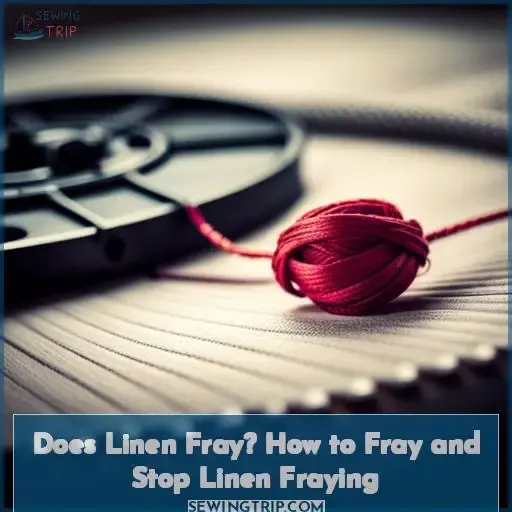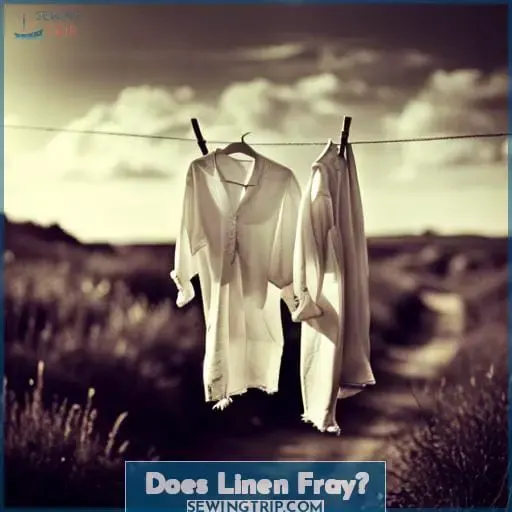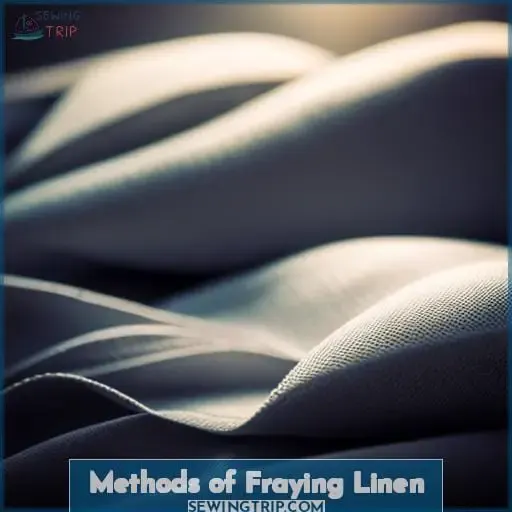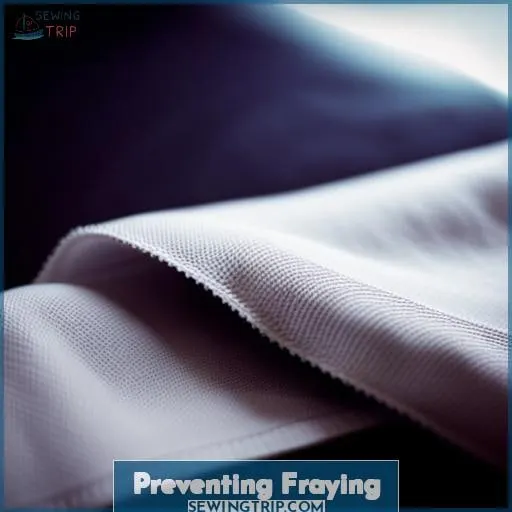This site is supported by our readers. We may earn a commission, at no cost to you, if you purchase through links.
 Looking to learn more about linen and its tendency to fray? In this article, we’ll delve into the world of fabric fraying and explore whether or not linen is prone to it. We’ll also provide you with practical tips on how to fray linen intentionally for a trendy shabby chic look, as well as ways to prevent fraying in your sewing projects.
Looking to learn more about linen and its tendency to fray? In this article, we’ll delve into the world of fabric fraying and explore whether or not linen is prone to it. We’ll also provide you with practical tips on how to fray linen intentionally for a trendy shabby chic look, as well as ways to prevent fraying in your sewing projects.
Table Of Contents
Key Takeaways
- Fraying splits apart fabric threads for visual interest; works well with linen, cotton, silk. Adds rustic charm.
- Table linens, scarves, quilts, some apparel can be frayed along edges for decorative texture.
- To prevent fraying, use pinking shears, tape, sew edges, or apply seam sealant to create a protective barrier.
- Lighter weight, loose weave linens more prone to fraying than tighter woven options. Test different fabrics.
Does Linen Fray?
Yes, linen does fray. It’s a natural fabric made from flax fibers, and like other fabrics, it can unravel at the edges if not properly cared for. However, there are methods to prevent fraying and maintain the integrity of your linen items such as using pinking shears or sewing the edges.
Understanding how to handle and care for linen will help you preserve its quality over time.
Items to Fray Fabric
If you’re looking to fray fabric, one of the items that can be frayed is linen.
Table linens, scarves, quilts, jeans, jackets, sweaters, hats, curtains, rugs, and other fabrics with looser weaves can be frayed for decorative edges.
Focus on soft linens, cottons, denims that have been pre-washed. Tighter woven fabrics may not fray as easily.
Test different items to find ones that give you the frayed fabric edge you desire for your projects.
Types of Fabric to Fray
Linen is one of the lightweight fabrics that can be frayed to create a unique and textured look.
Other fabrics like cotton, silk, wool, and synthetic materials can also be frayed for added visual interest.
Frying fabric edges adds a rustic charm to projects such as scarves or table linens.
Whether it’s natural or synthetic fabric, fraying allows you to experiment with different textures and designs while adding an element of creativity to your sewing projects.
Methods of Fraying Linen
When it comes to fraying linen, there are several methods you can try.
One option is using pinking shears to create a zigzag pattern along the edges of the fabric, which helps prevent fraying while adding a subtle effect.
Another method involves using a seam ripper to stitch across the top and then cutting vertically, allowing loose threads to fray naturally.
Alternatively, you can achieve a slightly frayed look by tearing the fabric at specific points or chopping vertical lines and washing them for faster fraying.
Fraying Fabric With Pinking Shears
To fray linen fabric, start by using pinking shears to cut a zigzag line across the section you want to have a frayed edge.
Pinking shears are ideal for creating a subtle fraying effect on your fabric. Simply grip the pinking shears firmly and slowly cut along the desired area in a back-and-forth motion.
The jagged edges created by the pinking shears will prevent excessive unraveling while adding an interesting texture to your fabric edge.
Fraying Fabric With a Seam Ripper
Stitch across the linen where you’d like the fraying to stop, then cut vertically and pull the loose threads to fray them.
- Use a seam ripper for precise cuts and controlled fraying
- Snip close together for heavy fraying
- Space cuts farther apart for subtle fraying
- Cut longer strips for maximum fraying effect
- The thickness depends on the linen’s texture
Fraying Fabric by Tearing
By tearing a linen fabric and snipping at the area you’ve chosen, you’ll then get to pull it to the edge for achieving a slightly frayed appearance.
To tear linen evenly by hand without cutting, grasp the fabric firmly in both hands, apply steady tension, and pull.
For more precision, use a knife to start tears then pull carefully to control fraying. With practice, you can get clean tears and customized frayed effects on linen napkins.
Fraying Fabric by Chopping and Washing
You can fray linen by chopping long vertical lines into it at regular intervals before washing it without any other articles, as the finer the cuts, the faster it will fray.
- Use a rotary cutter or very sharp scissors for clean, precise chops.
- Space the chops 1/4-1/2 inch apart for a subtle fray.
- For a more distressed look, make finer chops 1/8 inch or closer.
Preventing Fraying
To prevent fraying in linen, there are several methods you can try.
- One option is to deliberately fray the edges by removing loose threads, although this may make your project look messy.
- Another method is using pinking shears to cut a zigzag pattern into the fabric, which helps prevent fraying but can leave behind bits of thread.
- Taping the edges or sewing them are more durable options that don’t leave residue, while using a seam sealant product creates a waterproof barrier and dries quickly but can be expensive.
Deliberately Fraying the Edges
One way to prevent linen from further fraying is to deliberately fray the edges ahead of time, which removes the loose threads that would otherwise continue unraveling. This method gives your linen a trendy and rustic look with its frayed edge texture.
You can achieve this by using specialized tools such as frayed edge scissors or by carefully sewing along the edges.
There are also helpful tutorials available for creating a beautiful frayed edge finish on your linen projects.
Using Pinking Shears
To prevent fraying in linen fabric, a useful method is to use pinking shears, which create a zigzag pattern along the edges.
Pinking shears come in various types and brands, each with their own unique features.
Here are some tips for using pinking shears effectively:
- Choose high-quality brands for clean cuts.
- Hold the fabric taut while cutting to avoid jagged edges.
- Regularly sharpen your pinking shears for optimal performance and longevity.
Proper care of your pinking shears will ensure they remain sharp and ready to stop fraying in your linen projects.
Taping the Edges
When preventing fraying, tape’s a quick and easy way to handle edges, but it may not stick well over time or leave residue.
Opt for fabric tape or twill tape over masking types to minimize gumminess.
Apply 1-2 along the cut edge, pressing firmly for max adhesion without restricting embroidery access.
Tape before beginning your project so stitches don’t loosen bonding.
Check often for lifting and reapply as needed to forestall fraying.
Fray stop glue also seals neatly.
Sewing the Edges
You’ll want to sew the edges of your linen for the most durable fray prevention.
Carefully turn under the raw edges and sew a straight stitch or zigzag stitch along the folded hem.
For extra strength, consider a double-fold hem, sewing twice along the edge.
If sewing a patch or applique, ensure clean edges before neatly stitching into place.
With attention and care, strong seams will withstand washing and wearing without fraying.
Using a Seam Sealant Product
One way you’re stopping linen fraying is using a seam sealant product.
Seam sealants are applied to the edges of the fabric to create a protective barrier that prevents fraying.
There are different types of seam sealant products available, such as liquid formulas or adhesive tapes.
The application process may vary depending on the product, but generally involves applying it directly onto the edge of the fabric and allowing it to dry.
Seam sealants can last for a long time, providing durable protection against fraying in your linen projects.
Consider options like Aleene’s Stop Fraying or explore alternative methods for preventing fraying in your cross stitch or creating beautifully finished napkins.
Frequently Asked Questions (FAQs)
Can linen be frayed without using any tools?
Yes, linen can be frayed without any tools.
By simply snipping at the desired point and pulling the fabric to the edge, you can achieve a slightly frayed look on your linen fabric.
How can I prevent linen from fraying after it has been cut?
To prevent linen from fraying after cutting, apply a seam sealant product to create a protective barrier. Embrace the power of mastery over fabric care and sewing issues with this simple solution.
Are there any specific types of linen that are more prone to fraying?
Certain types of linen, especially those with a looser weave or lighter weight, are more prone to fraying.
It’s important to handle them carefully and use appropriate techniques like seam sealing or deliberate fraying to prevent unraveling.
Can I use the same methods to fray other types of fabric besides linen?
Yes, you can use the same methods to fray other types of fabric besides linen.
Whether it’s soft linens, cotton, or denim, you can achieve that desired frayed look with techniques like tearing and using pinking shears.
Are there any alternative methods to prevent fraying besides the ones mentioned in the article?
Yes, there are alternative methods to prevent fraying.
You can use fabric glue or a clear nail polish on the edges of the fabric to seal them and stop fraying.
Conclusion
As you handle linen’s delicate threads, recognize that without care, fraying can undermine your work. Yet armed with pinking shears or binding tape, you can counteract this tendency.
Whether aiming to distress linen’s edges for aesthetic effect or to strengthen seams against untimely ravelling, a stitch in time will serve you well. Focus on fortifying each garment’s vulnerable points and you’ll discover linen’s beauty needn’t unravel.









